
Snoring / Obstructive Sleep Apnea
Obstructive Sleep Apnea
Obstructive Sleep Apnea (OSA) is an illness caused by the soft tissues in the back of the throat relaxing and completely closing off the airway. When this happens, air cannot reach the lungs and the amount of oxygen reaching the brain and body is reduced.
The brain’s lack of oxygen causes it to alert the airway muscles to tighten up and unblock the airway. This in turn causes the person to emit a loud gasp or snort as the breathing and sometimes snoring resumes.
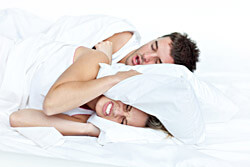
Possible Complications
Sleep apnea can be a life-threatening condition. People with OSA can suffer from lack of sleep, which can cause daytime sleepiness that leads to difficulty staying awake during meetings, conversation, while reading, watching television or driving. Untreated sleep apnea is a major factor in contributing to:
- High Blood Pressure
- Cardiovascular disease / Stroke
- Diabetes
- Depression
- Decreased libido / Impotency
- Motor vehicle accidents
- Headaches / Neck pain
- Memory loss
- Mood changes/Irritability
- Relationship disturbances
- Not waking refreshed
- Macular degeneration
- Glaucoma
- Weight gain / Difficulty losing weight
- People with Alzheimer’s Disease often have sleep apnea
Sleep apnea affects millions of adults and is undiagnosed in 90 % of individuals with the illness.
Symptoms of Obstructive Sleep Apnea
- Loud snoring
- Periodic stoppages in breathing
- Significant daytime sleepiness
- Restless sleep
- Difficulty concentrating
- Poor memory
- Irritability
- Personality change
Snoring
The sounds of snoring occur when air flows past our throat whole sleeping. The tissues vibrate and create the sound we recognize as snoring. Snoring is very common and occurs in almost half of all adults. Men are more likely to snore than women.
Snoring can be caused by nasal congestion, alcohol consumption, sleep apnea, certain medications or enlarged tonsils. A major contributor is a lower jaw position that is too closed and/or retruded. This improper position closes off the airway, and is caused from teeth that do not properly support the jaw in the ideal position. This is why a dentist should be involved in OSA treatment.
You don’t have to Snore to have Sleep Apnea!
It’s called Upper Airway Resistance Syndrome (UARS). UARS is a sleep disorder characterized by airway resistance to breathing during sleep. It is thought to be the precursor to mild obstructive sleep apnea. The primary symptoms include daytime sleepiness, excessive fatigue, headaches and many of the same symptoms as TMD/CMD. Middle-aged women are affected more often than men.
Sleep Apnea Diagnosis
The only way to rule out high blood pressure is to measure it. The same is true with sleep apnea, and the test is called a sleep study.
- This can be done in a Sleep Center
- In your own bed
- Dentist Charles A. Smith can arrange the referral for you
A sleep physician then makes the diagnosis and recommendations for treatment. There are different levels of severity, but all levels carry risk, and in general sleep apnea worsens with time, age and weight.
AHI (Apnea-Hypopnea Index) or the RDI (Respiratory Disturbance Index) are the standard measurements in determining the level of sleep apnea.
AHI or RDI at:
0-4 Normal Sleep
5-15 Mild Sleep Apnea
16-30 Moderate Sleep Apnea
31- Severe Sleep Apnea
Treatment – Severe OSA
The gold standard is the continuous positive airway pressure (CPAP) machine. This machine has saved so many lives, and if you need it, a new world of well being awaits you. This machine is literally a life-saver! The down side of CPAP is that many people do not use it on a regular basis or stop using it all together. This is life threatening.
Treatment – UARS, Mild, Moderate OSA
A carefully constructed adjustable oral appliance which optimizes the airway and supports the jaw by an appropriately trained dentist can be an alternative. This therapy is referred to as an Oral Appliance Therapy or Mandibular Advancement Device or Appliance.
Many different types of appliances have been made over the years to treat sleep apnea. The best ones have the following features:
- Custom made
- Relaxed physiological, neuromuscular jaw position
- Adjustable if necessary
- Can open mouth and speak
- Comfortable to wear
- Continued monitoring and measurements
Charles a. Smith’s physiological jaw position standard of care for OSA Appliance:
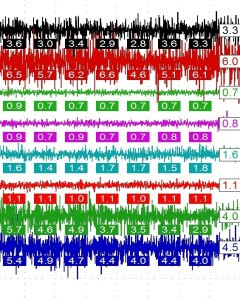
Muscle activity before OSA Appliance
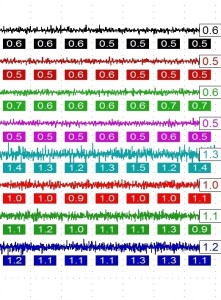
Muscle activity with OSA Appliance in the mouth
Charles A. Smith DDS offers three types of Mandibular Advancement Devices
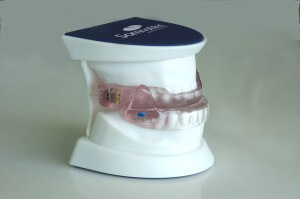
Somnodent® Mandibular Advancement Device
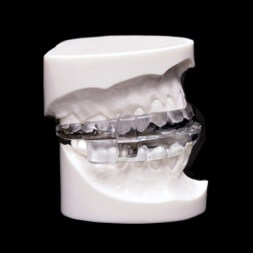
Somnodent® Mandibular Advancement Device
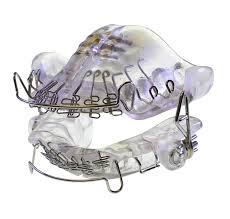
mRNA Appliance®
The mRNA appliance (mandibular re-positioning nighttime appliance) is a FDA-cleared and patented biomimetic oral appliance that provides combined maxillo-mandibular correction. The appliance is two DNA appliances that will correct the airway over time so that the patient will no longer require any device or machine. This means it permanently corrects UARS, and mild to moderate obstructive sleep apnea (OSA).
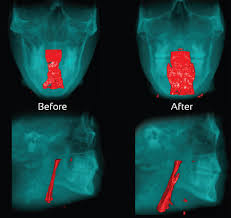
Airway correction with mRNA Appliance
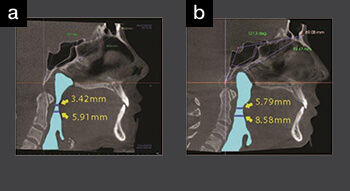
Airway correction with mRNA Appliance
Charles A. Smith DDS has studied extensively in the area of Sleep Medicine, and gets great satisfaction from seeing patients get their well-being back from obstructive sleep apnea.
